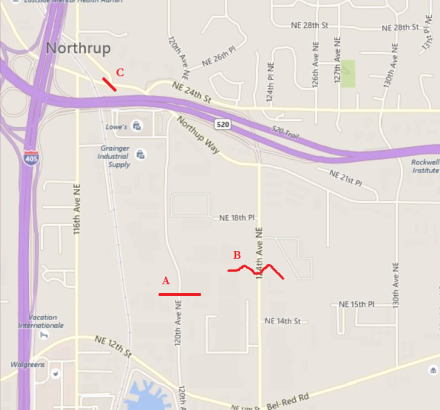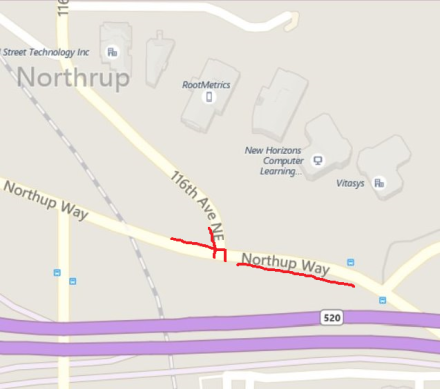To be honest, I don’t recommend it. This intersection is not designed for people despite the large number that walk and bike through it, and it’s only a matter of time before someone is hurt or killed. But here’s what you’ll find.
First, let’s orient ourselves:
Yes, that’s a lot of road. The north side of the intersection is a 520 off-ramp. The south side is a 520 on-ramp. The trail runs along the west side of the intersection. Many are going to Microsoft, which often means heading east along 40th. The south side of the bridge has a fairly wide ped/bike path. The north side has a narrow sidewalk. The bridge at 36th is much nicer to use since there isn’t a highway interchange. The bridge at 51st has no bike facilities. That intersection has most of the same problems as at 40th. However, it can be used to access the northern reaches of the main Microsoft campus.
The (north-south) trail crossing is given an approximately 3 second green signal at the beginning of the off-ramp (facing south) vehicular traffic’s green light. There is then a 30 second countdown where it is illegal to enter the intersection on foot or bike, but then it’s an entire cycle until the next 3 second chance. Most ignore this law. Drivers often assume it is followed.
There is no north-south crossing on the east side of the intersection.
The east-west crossing on the south side is given a slightly longer green signal while the east-west vehicular traffic also has green. The green and ensuing countdown are shorter than the east-west vehicular green light. There is also a period where the eastbound traffic is stopped and a left arrow is given for westbound traffic to turn onto the on-ramp.
The east-west crossing on the north side is given a green signal during the entire east-west vehicular green light. However, this is only really useful on foot.
Right-turn-on-red is allowed for both of the possible right turns and is the biggest problem. Drivers turning right onto the on-ramp often stop on the crosswalk rather than the stop line, assuming they stop at all, before looking for vehicular traffic blocking their turn. Drivers turning right off of the off-ramp will pull far enough forward that they no longer can see people waiting on the corner. Then when the light turns green this right turn conflicts with the trail crossing.
Crossing southbound:
There is usually a driver waiting for an opportunity to turn right on red when the cycle changes to green for the off-ramp and trail. This driver often won’t look and would run over anyone entering the intersection immediately. Unfortunately, once this car has cleared, the trail will already be on the countdown timer, so legally it is impossible to cross. The next car will be in a better position to see the trail traffic and usually, but not always, will wait. After this, the issue is traffic that is approaching the intersection during the green light. They will be moving at highway speeds and since 40th is so wide they can physically navigate the turn at high speed as well, and some do.
At the median, there might be a car blocking the crosswalk in the first lane of eastbound traffic.
Lastly, it is common for a driver in the right-turn lane (so, the last lane to cross for southbound pedestrians and bicyclists) to blindly pull through the crosswalk before looking for anything. Always slow and peek around the cars in the next-to-last lane.
Crossing northbound:
Of course northbound has the same set of obstacles as southbound, though they present themselves a bit differently. When the crosswalk signal turns green, cars in the right turn lane will be seeing the first break in traffic from the cars turning left onto the on-ramp (since the light has just turned red), so expect one to make this turn without looking for trail traffic. On the other side, cars may be moving after the southbound trail traffic has cleared, and the drivers will be eager to go.
[Edit: The signal phasing has changed so that the left turn onto the 520 on-ramp is now at the beginning of the east-west phase rather than the end. In practice this means the right-turn lane onto 520 might be empty at the beginning of the north-sound phase, so it sometimes removes a conflict.]
Crossing east-west:
If you are a pedestrian going between the northwest and southeast corners of the highway exchange, you can avoid the two miserable crossings by using the north side of the bridge. The crosswalks at 156th are much more pleasant.
The south side’s east-west crossing has the problem of conflicting with right-turning traffic onto the on-ramp. (“Conflicting” here means both groups have green lights at the same time.) So the green pedestrian signal is hardly a promise of safety. On top of this, drivers find all sorts of ways to abuse the left turn onto the on-ramp. A lot of it stems from them getting blocked from making the turn while they have the green and then just doing it whenever the blockage clears.
Commentary:
It’s a complete embarrassment that WSDOT allows right-turn-on-red at this busy intersection. I can’t take anything any of their officials say about safety seriously while they let this abomination continue. The city of Redmond should be pushing hard for this as well but does not. Stopping right-turn-on-red wouldn’t be a complete fix, but it would help a lot. Stronger measures should probably also be taken (e.g., raised crosswalks, separate phase for pedestrians/bicycles), but they will never happen because WSDOT prioritizes the movement of cars to the meter on the on-ramp or the next intersection where they will need to stop again anyway.
There were recent small modifications to the intersection. The turning radii for the problematic right turns were slightly reduced. However, both right turns end on such wide roadways that it hardly matters. Some bicyclists have reported that the geometry is somewhat improved so that they are in a better position to be seen before entering the intersection. This isn’t something that I’ve noticed, but hopefully it’s a little better. The new median seems to only provide a chokepoint for the trail traffic as well as confusing a few drivers about where the stop line is.
The long-term hope is a tunnel under the intersection for the trail and a separate bridge over 520 for access to Microsoft. These are expensive but probably the most realistic option. And they should be quite nice to use. Unfortunately they will result in this intersection getting even crazier, so pedestrians will be forced to the tunnel or 152nd and vehicle collisions will probably increase.




